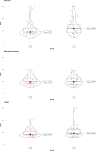Effect of cold environments on technical performance and perceived workload and stress during advanced medical procedures: a randomized controlled simulation study
- PMID: 40598316
- PMCID: PMC12211314
- DOI: 10.1186/s13049-025-01373-8
Effect of cold environments on technical performance and perceived workload and stress during advanced medical procedures: a randomized controlled simulation study
Abstract
Background: Advanced medical procedures in prehospital settings are often performed in hostile environments, where cold temperatures may impair manual and cognitive performance. Although such procedures are essential in mountain rescue missions, the effects of cold conditions on their execution and associated workload and stress are unknown.
Objective: This randomized controlled simulation study evaluated differences in performance, perceived workload, and stress during the execution of three advanced emergency medical procedures under cold (- 20 °C) versus control (+ 20 °C) ambient temperatures. Additionally, the study examined the influence of operator experience on these outcomes.
Methods: Thirty-six members of the International Medical Commission for Alpine Rescue participated in a crossover study conducted at the terraXcube environmental simulator in Bolzano, Italy. Participants performed orotracheal intubation via videolaryngoscopy (OTI-VLS), mini-thoracostomy, and front-of-neck airway (FONA) procedures under both temperature conditions. Time to procedure completion, number of attempts, and perceived workload and stress (using the NASA Task Load Index and Visual Analogue Scale) were measured. Operators were categorized into high or low experience groups based on self-reported prior procedure frequency.
Results: Time to complete the procedures tended to be longer in cold conditions for all procedures, with the largest difference observed for OTI-VLS (14 s, p = 0.076). Success rates exceeded 90% on the first attempt under both conditions. Perceived workload and stress increased significantly in cold environments across all procedures, especially for less experienced participants. Experienced operators completed OTI-VLS and mini-thoracostomy significantly faster and reported lower stress and workload levels compared to their less experienced counterparts.
Conclusions: While cold environments had low impact on procedural time, they significantly increased perceived workload and stress among rescue personnel. Experience mitigated these effects, emphasizing the importance of tailored training programs to enhance both technical and non-technical skills in challenging conditions. While this study has explored the impact of temperature, it would be valuable to investigate how other environmental factors, such as wind and rain, might affect clinical actions.
© 2025. The Author(s).
Conflict of interest statement
Declarations. Ethics approval and consent to participate: The study was approved by the Ethics Institutional Review Board for Clinical Studies of Bolzano (protocol number 80–2023). Competing interests: The authors declare that they have no competing interests.
Figures



Similar articles
-
Sexual Harassment and Prevention Training.2024 Mar 29. In: StatPearls [Internet]. Treasure Island (FL): StatPearls Publishing; 2025 Jan–. 2024 Mar 29. In: StatPearls [Internet]. Treasure Island (FL): StatPearls Publishing; 2025 Jan–. PMID: 36508513 Free Books & Documents.
-
Videolaryngoscopy versus direct laryngoscopy for adult patients requiring tracheal intubation.Cochrane Database Syst Rev. 2016 Nov 15;11(11):CD011136. doi: 10.1002/14651858.CD011136.pub2. Cochrane Database Syst Rev. 2016. Update in: Cochrane Database Syst Rev. 2022 Apr 4;4:CD011136. doi: 10.1002/14651858.CD011136.pub3. PMID: 27844477 Free PMC article. Updated.
-
Comparison of self-administered survey questionnaire responses collected using mobile apps versus other methods.Cochrane Database Syst Rev. 2015 Jul 27;2015(7):MR000042. doi: 10.1002/14651858.MR000042.pub2. Cochrane Database Syst Rev. 2015. PMID: 26212714 Free PMC article.
-
Videolaryngoscopy versus direct laryngoscopy for adults undergoing tracheal intubation.Cochrane Database Syst Rev. 2022 Apr 4;4(4):CD011136. doi: 10.1002/14651858.CD011136.pub3. Cochrane Database Syst Rev. 2022. PMID: 35373840 Free PMC article.
-
Assessment of prehospital tracheal intubation technique using initial direct laryngoscopy during videolaryngoscopy: randomized controlled simulated trial.BMC Emerg Med. 2025 Jul 1;25(1):112. doi: 10.1186/s12873-025-01266-0. BMC Emerg Med. 2025. PMID: 40596822 Free PMC article. Clinical Trial.
References
-
- Pietsch U, Knapp J, Kreuzer O, Ney L, Strapazzon G, Lischke V, Albrecht R, Phillips P, Rauch S. Advanced airway management in hoist and longline operations in mountain HEMS—considerations in austere environments: a narrative review This review is endorsed by the International Commission for Mountain Emergency Medicine (ICAR MEDCOM). Scand J Trauma, Resusc Emerg Med. 2018;26(1):23. 10.1186/s13049-018-0490-5. - PMC - PubMed
-
- Thoeni N, Piegeler T, Brueesch M, et al. Incidence of difficult airway situations during prehospital airway management by emergency physicians–a retrospective analysis of 692 consecutive patients. Resuscitation. 2015;90:42–5. 10.1016/j.resuscitation.2015.02.010. - PubMed
Publication types
MeSH terms
Grants and funding
- Missione 4 Componente 2, Investimento 1.5 D.D. 1058 23/06/2022, ECS_00000043/European Union Next-GenerationEU (Piano Nazionale di Ripresa e Resilienza (PNRR) - the consortium iNEST (Interconnected North-East Innovation Ecosystem))
- Missione 4 Componente 2, Investimento 1.5 D.D. 1058 23/06/2022, ECS_00000043/European Union Next-GenerationEU (Piano Nazionale di Ripresa e Resilienza (PNRR) - the consortium iNEST (Interconnected North-East Innovation Ecosystem))
LinkOut - more resources
Full Text Sources
Medical

